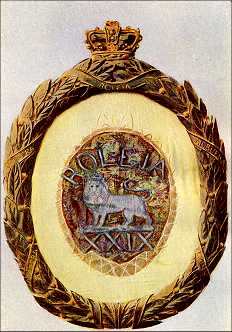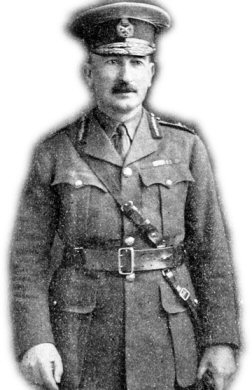The Royal Lion
The Lion first appeared to be used by the Worcestershire Regiment before 1800 and was to be seen on officer's shoulder belt plate. There is evidence of this on a Cross-Belt Plates shown in Major Hugh Everard's (later Colonel) History of the 29th (Worcestershire) Regiment published in 1891, with a photograph on page 184. It describes it as follows:- "Shoulder-belt plate of Captain Edgell Wyatt, 3ins. long, 2¼ins. broad. Silver plate with wreath of laurels engraved round the edge. "Raised device of Lion and crowned garter in centre. Wyatt served in the 29th from 1793 to 1803. This is the earliest record of the Lion device that can be traced." This plate appears to have been in use at least in 1796, and may have been in use as early as 1792. For a period the Lion ceased to be used in 1855, but was still seen on the officers' undress cap badge of that peroid. It appeared again in 1890 as the central motif of nearly all of the Worcestershire Regiment badges, where it remained until 1970 when the regiment was amalgamated with the Sherwood Foresters Regiment. |
|
For the origin of the device we must go back to the Middle Ages. In those days a knight in battle was completely encased in armour, and his identity could only be known by the heraldic devices he displayed. Of these the principal recognised distinctions were the devices painted on his shield or "escutcheon," and the device which ornamented the top of his helmet and which was known as his "crest."
Sometimes these devices were identical, but more often they were widely different. In the case of the Kings of England the "escutcheon" has, since very early days, always been three lions "passant gardant" (which means "walking along but looking towards the spectator") on a red field. The "crest" which surmounted the Royal helmet, however, was different. There the Lion was made "statant" (which means "standing") with all four feet on the helmet. The earliest known example of this Royal Lion crest is to be seen on the helmet which hangs above the tomb of the Black Prince in Canterbury Cathedral. There the Lion will be seen stiffly erect, made in leather, and glaring over the front of the helmet. The fact that the "crest" on a helmet was of necessity a comparatively simple design, whereas the devices on the "escutcheon" could be infinitely complicated, led to the general use of representations of the "crest" for many purposes which required a simple and distinctive design; for example for seals. When, in Tudor times, the wearing of armour was discontinued the original purpose of a "crest" was forgotten, and its use for decorative purposes only considered. It is to this mistaken use of "crests" as, so to speak, "badges" that we owe the fact that the Lion of the Royal Crest is generally depicted (e.g. on the back of an old shilling) with his head turned towards the spectator; on a helmet his head must, of necessity, have faced forward. |
English shilling (1825) |
It is interesting to note that probably the last "crest" actually worn was the eagle which decorated the Kaiser's helmet. We should note also that the practice of using representations of a "crest" on seals and notepaper has led to general misuse of the word; it is quite incorrect to speak of the Regimental "badge" on notepaper as a "crest," although stationers persistently do so.
The date at which the Lion of the Royal Crest was given a crown on his head is somewhat uncertain; but in Stuart times he was so shewn, and it. is the crown which particularly distinguishes him from the Lions borne on the "Escutcheon" of the Arms of England. It is one of those three uncrowned Lions from the "Escutcheon" of England which has been for so long the Badge of the King's Own Regiment; it must be understood that the Lion of the King's Own is "passant" and bears no crown, whereas the Lion of the Worcestershire Regiment is "statant" and crowned.
Shoulder-Belt Plate of |
How the Royal Lion came to be granted as a badge to our Regiment is not yet definitely known. The first proof of the existence of the badge is an officer's belt-plate of 1796 which bears the device of the Lion. The Royal Crest is nowadays understood to mean the combined device of the Royal Lion and the Crown; as such it has been borne by several Regiments and Corps. But the Lion alone, without the Crown, was borne by the 29th Foot (Worcestershire Regiment), and this device is rare. There is one other case of its use; about the time that the device appears first to have been granted to the Worcestershire Regiment, it was also worn by the officers of the King's Company of the Grenadier Guards. The officers of the other Companies of the 1st Guards, as the Grenadiers were then called, wore as their badge the Star of the Garter. In 1791 the 29th Foot (Worcestershire Regiment), then newly returned from America, went to Windsor for duty while the Guards were away. The Commanding Officer, Colonel Lord Cathcart, had recently been brought into the Regiment from the 1st Foot Guards. He was a personal friend of the Royal Family, and it is largely to his influence that the Worcestershire Regiment can attribute the grant to the Regiment of the Quickstep "Royal Windsor," composed by the King's daughter, Princess Augusta. It is probable that he it was who obtained for the Regiment the Royal device of the crowned Lion. Another theory is that the badge was granted to commemorate the "Glorious First of June" three years later (1794). Although this is possible, it is strange that no memory of this grant should have been preserved. Whatever its origin, there is no doubt that the badge was in use in 1796, and that the officers' belt plates, which twenty years before had borne the elongated star, then bore the Royal Lion; and the device has been retained by the Regiment ever since. |
The date on which the Lion device was first placed on the Worcestershire Regiment colours is uncertain; all that is certain is that the badge was so borne in the Peninsular War. The central fragment of a Regimental Colour, bearing the device of the Royal Lion combined with the numerals "XXIX," with the Battle-Honour
The Colours which were carried in the Peninsular War were replaced about 1816 by a new stand of Colours. This new stand of Colours were subsequently (1841) presented to Lord Strafford, then Colonel of the Worcestershire Regiment and are still in existence, preserved at Strafford House as heirlooms. The new Colours then issued did not bear the device of the Royal Lion. Apparently the original grant of the badge had not been properly recorded, since no trace of it was found in the Herald's College; though in the midst of a Great War (1914-18) this lack of record is perhaps not extraordinary. Unfortunately in 1816 no effort seems to have been made by the officers who had been brought in to replace the casualties of Albuhera to preserve the Lion Badge, and the new Colours bore simply the number of the Regiment. But though the Lion device was not thenceforward borne on the Colours, it continued to be regarded as the principal badge of the Regiment. The device was borne on the officers' belt plates and shakos until the general change of uniforms after the Crimean War. In 1879 the device was revived, by the efforts of the late Colonel Everard, first as part of the Officers' Puggaree badge and then, in 1887, as the central device of the Regimental Star badges. As such it has ever since been borne. It was normal practice to record in the Army List only those badges which are borne on the Colours of Regiments, and until the Lion badge was restored to the Colours it could not be shown in its proper place among the badges of the Worcestershire Regiment. Consequently in the 1920's the question of its restoration was taken up, and the old device was once more placed on the Colours. |
The Lion Badge |
The question of requesting permission to revert to the Regiments correct star was raised before the First Worls War, and would have been taken up in 1914; but the Great War caused any such project to subside, and it was not until 1919 that it was possible seriously to take up the question again. The proposal for the restoration of the old star was first raised by Major J. M. Monk, M.C. (by whose subsequent death in the Sudan the Regiment has lost one of its best and keenest officers), and was much helped by the concurrence and kind assistance of Colonel H. J. Bartholomew, D.S.O., then the Senior Battalion Commander.
Eventually, after much correspondence, it was decided to appoint a small Committee to deal with the matter. This Committee, consisting of Lieut.-Colonel H. A. Carr, D.S.O. (2nd Battalion Worcestershire Regiment), Captain C. F. G. Crawford and Captain H. Fitz M. Stacke (both old 1st Battalion officers), met several times in London. After examining all badges of the Regiment past and present, and also all the star badges worn by other Regiments, the Committee came to the following conclusions :
1. That the existing cap-badge, especially that of the rank and file, was incorrect in shape and easily confused with that of at least three other Regiments.
2. That the Regiment was clearly entitled to wear an elongated star; that no other Regiment of the Line was now wearing an elongated star badge or was likely to claim one; and that the only other similar badge was that of the officers of the Coldstream Guards. Consequently that an elongated star badge, if officially granted to the Regiment, would be quite distinctive.
3. That the scroll below the star on the cap-badge served no useful purpose, as the lettering was indistinguishable at three paces, and on the contrary obscured the shape of the star, and caused confusion with other Regiments.
4. That in order to emphasise the elongated shape of the star, and to ensure that in future manufacturers did not revert to a circular shape, the centre of the star should be oval, as in the old badges of the Regiment and as in the badge of the Coldstream officers.
With these general principles agreed, the Committee then proceeded to the details of the design of the badge. As will be seen from the attached illustrations, both Battalions of the Regiment had in the past worn elongated stars with oval centres. The problem was how to combine the designs.
The design eventually adopted was a compromise between the two as far as the shape of the star was concerned, retaining, however, the Garter borne by the old 29th.
The centre device of the badge as designed was a combination of the distinctive devices of the two old Battalions—the Royal Lion of the 29th and the "Firm" of the 36th.
The Committee also recommended that the Badge should, as far as possible, be the same for all ranks, that the star should be silver, the Garter gilt, and the centre device silver, this being the arrangement of metals in the existing officers' badges. A further advantage of introducing a silver star for the rank and file was considered to be the probability of preventing confusion with other Corps wearing stars made of brass.
After the design of the Badge had been completed, nearly three years' work was necessary before the consent of all Battalions and of the War Office had been obtained.
On the 24th April 1923 a War Office letter notified that His Majesty had been graciously pleased to approve of the restoration to the Regiment of its old form of badge, in the shape of a properly elongated star.
Field-Marshal Sir Claud Jacob |
In 1930 at the request of the Colonel of the Regiment, Field-Marshal Sir Claud Jacob, G.C.B., G.C.S.I., K.C.M.G., the War Office authorised certain amendments in Army Order 51 of 1924 by which the device of “The Lion of the Royal Crest” was authorised to be borne in the centre of the Worcestershire Regimental Colours. This device was borne, in the centre of the Regimental Colour saved by Ensign Vance in the Battle of Albuhera; but it had not been officially recorded (or the official record had been lost), with the result that in announcing His Majesty’s permission for the badge again to be borne on our Colours the Army Order of 1924 mistakenly referred to the device as a “new” badge.
ARMY ORDER 51 OF 1924 AS AMENDED BY ARMY ORDER 132 OF 1930. HONORARY DISTINCTION — WORCESTERSHIRE REGIMENT. His Majesty the King has been graciously pleased to approve of The Worcestershire Regiment bearing the following badge on its Colours, viz. :— “The Lion of the Royal Crest.” This device will be combined with the motto “FIRM” and the heraldic description of the badge will be as follows:- “Upon a pedestal inscribed ‘FIRM,’ the Lion of the Royal Crest.” This badge, combining the historic devices of the old 29th and 36th Regiments, will be borne in the centre of the Regimental Colours. |

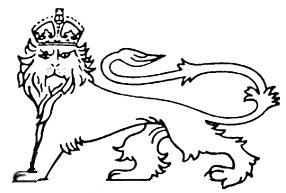
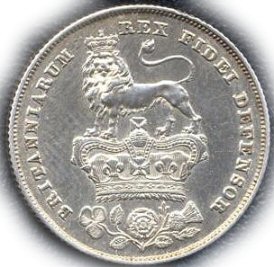
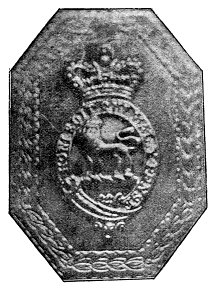
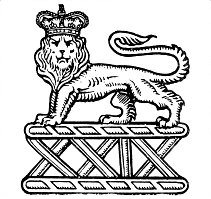 "ROLEIA" embroidered above, is now framed and held by the Worcestershire Regiment Museum. The Battle-Honour "ROLEIA" was granted in 1812.
"ROLEIA" embroidered above, is now framed and held by the Worcestershire Regiment Museum. The Battle-Honour "ROLEIA" was granted in 1812.